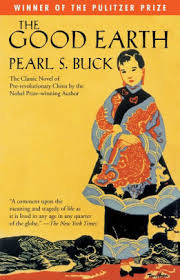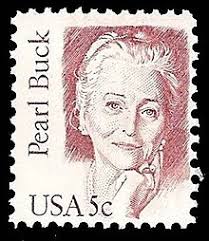Hers was not a typical childhood. The daughter of missionaries; she called upon her childhood experiences to write a series of novels about the Chinese people. A Nobel Prize winner, her masterpiece was The Good Earth. She of course, was Pearl S. Buck and she said, “You cannot make yourself feel something you do not feel, but you can make yourself do right in spite of your feelings.”
of missionaries; she called upon her childhood experiences to write a series of novels about the Chinese people. A Nobel Prize winner, her masterpiece was The Good Earth. She of course, was Pearl S. Buck and she said, “You cannot make yourself feel something you do not feel, but you can make yourself do right in spite of your feelings.”
Originally named Comfort by her parents, Pearl was born in Hillsboro, West Virginia, to Caroline and Absalom Sydenstricker, Southern Presbyterian missionaries who had traveled to China shortly after their marriage in July, 1880, but returned to the USA for their daughter’s birth. When she was five months old, the family returned to China.
She recalled in her memoir that she lived in “several worlds”, one a “small, white, clean Presbyterian world of my parents”, and the other the “big, loving, merry, not-too-clean Chinese world,” and there was no communication between them. The Boxer Uprising greatly affected the family; their Chinese friends deserted them, and Western visitors decreased. Her father, convinced that no Chinese would wish him harm, stayed behind as the rest of the family fled to Shanghai for safety.
A few years later, Pearl was enrolled in Miss Jewell’s School, and was dismayed at the racist attitudes of the other students, few of whom could speak any Chinese. Both of her parents felt strongly that Chinese were their equals (they forbade the use of the word heathen), and she was raised in a bilingual environment: tutored in English by her mother, in the local dialect by her Chinese playmates, and in classical Chinese by a Chinese scholar named Mr. Kung. She also read voraciously, especially, in spite of her father’s disapproval, the novels of Charles Dickens, which she later said she read through once a year for the rest of her life.
In 1911, Pearl left China to attend college in Lynchburg, Virginia, graduating Phi Beta Kappa in 1914. Although she had not intended to return to China, much less become a missionary, she applied to the Presbyterian Board and served as a Presbyterian missionary from 1914 to 1932, but her views later became highly controversial and lead to her resignation.
She married an agricultural economist missionary, John Lossing Buck in 1917, and they moved to a small town on the Huai River. This region was described in her books The Good Earth and Sons.
From 1920 to 1933, the Bucks made their home in Nanjing where they both had teaching positions. She taught English Literature. In 1920, the Bucks had a daughter, Carol, afflicted with phenylketonuria. In 1921, Buck’s mother died of a tropical disease, and shortly afterward her father moved in. In 1924, they left China for John Buck’s year of sabbatical and returned to the United States for a short time, during which Pearl Buck earned her master’s degree from Cornell University. In 1925, the Bucks adopted Janice. That autumn, they returned to China.
The tragedies and dislocations that Buck suffered in the 1920s reached a climax in March 1927, during the “Nanking Incident.” In a confused battle involving elements of Chiang Kai-shek‘s Nationalist troops, Communist forces, and assorted warlords, several Westerners were murdered. The Bucks stayed in a hut while the family house was looted. After a terrifying day spent in hiding, they were rescued by American gunboats, traveled to Shanghai and then sailed to Japan, where they stayed for a year, after which they moved back to Nanjing. Pearl later said that this year in Japan showed her that not all Japanese were militarists.
When she returned from Japan in late 1927, Pearl devoted herself in earnest to the vocation of writing. Friendly relations with prominent Chinese writers of the time encouraged her to think of herself as a professional writer. She wanted to fulfill the ambitions denied to her mother, but she also needed money to support herself if she left her marriage, which had become increasingly lonely; and since the mission board could not provide it, she also needed money for Carol’s specialized care.
Pearl went once more to the States in 1929 to find long-term care for Carol, and while there met Richard J. Walsh, editor at John Day Publishers in New York, who accepted her novel East Wind, West Wind. Thus began a relationship that would result in many years of professional teamwork. Back in Nanking, she retreated every morning to the attic of her university bungalow and within the year completed the manuscript for The Good Earth.
When John Buck took the family to Ithaca, Pearl accepted an invitation to address a luncheon of Presbyterian women at the Astor Hotel in New York City. Her talk was titled “Is There a Case for the Foreign Missionary?” and her answer was a barely qualified “no”. She told her American audience that she welcomed Chinese to share her Christian faith, but argued that China did not need an institutional church dominated by missionaries who were too often ignorant of China and arrogant in their attempts to control it. When the talk was published in Harper’s magazine the scandalized reaction led Pearl to resign her position with the Presbyterian Board. In 1934, Pearl left China, believing she would return, while John remained.
In 1935 the Bucks divorced in Reno, Nevada, and Pearl married Richard Walsh that same day. He offered her advice and affection which, her biographer concludes, “helped make Pearl’s prodigious activity possible.” The couple lived in Pennsylvania until his death in 1960.
During the Cultural Revolution, Buck, as a preeminent American writer of Chinese village life, was denounced as an “American cultural Imperialist.” She was heartbroken when she was prevented from visiting China with Richard Nixon, and was repeatedly refused all attempts to return to her beloved China and was therefore compelled to remain in the United States for the rest of her life
Pearl S. Buck died of lung cancer on March 6, 1973, in Danby, Vermont. and was interred in Green Hills Farm in Perkasie, Pennsylvania.. She designed her own tombstone. Instead of her name being inscribed in English, the grave marker is inscribed with Chinese characters representing the name Pearl Sydenstricker.
Buck was highly committed to a range of issues that were largely ignored by her generation. Many of her life experiences and political views are described in her novels and short stories. She wrote on diverse subjects, including women’s rights, Asian culture, immigration, adoption, missionary work, war, the atomic bomb and violence.
She was involved in the charity relief campaign for the victims of the 1931 China floods, writing a series of short stories describing the plight of refugees, which were broadcast on the radio in the United States and later published in her collected volume The First Wife and Other Stories. In 1949, outraged that existing adoption services considered Asian and mixed-race children unadoptable, Buck co-founded Welcome House, Inc. the first international, interracial adoption agency, along with James A. Michener, Oscar Hammerstein II and his second wife Dorothy Hammerstein. In nearly five decades of work, Welcome House has placed over five thousand children.
In 1964, to support children not eligible for adoption, Buck established the Pearl S. Buck Foundation; to address poverty and discrimination faced by children in Asian countries; and in the same year, she opened the Opportunity Center and Orphanage in South Korea; later offices were opened in Thailand, the Philippines, and Vietnam. When establishing Opportunity House, Buck said, “The purpose … is to publicize and eliminate injustices and prejudices suffered by children, who, because of their birth, are not permitted to enjoy the educational, social, economic and civil privileges normally accorded to children.”
 Long before it was considered fashionable or politically safe to do so, Buck challenged the American public by raising consciousness on topics such as racism, sex discrimination and the plight of Asian war children. During her life, she combined the careers of wife, mother, author, editor, international spokesperson, and political activist.
Long before it was considered fashionable or politically safe to do so, Buck challenged the American public by raising consciousness on topics such as racism, sex discrimination and the plight of Asian war children. During her life, she combined the careers of wife, mother, author, editor, international spokesperson, and political activist.
In 1973, Buck was inducted into the National Women’s Hall of Fame. and in 1983 was honored with a 5¢ Great Americans series postage stamp issued by the United States Postal service. In 1999 she was designated an Honoree during Women’s History Month by the National Women’s History Project.
Thanks for the education on Pearl. I liked the name Comfort even better. Her parents were something in their own right and then to have such an amazing daughter. I hoped they lived long enough to appreciate her accomplishments. /crt
Very interesting, Estelle!
Estelle,
You amaze me, and educate me a bit more with each of your works of literary arts. I think America needs a new Pearl Buck to revitalize necessary, but currently absent values from our public life and times.
Thanks, and I hope you’re well.
Jim Gulley